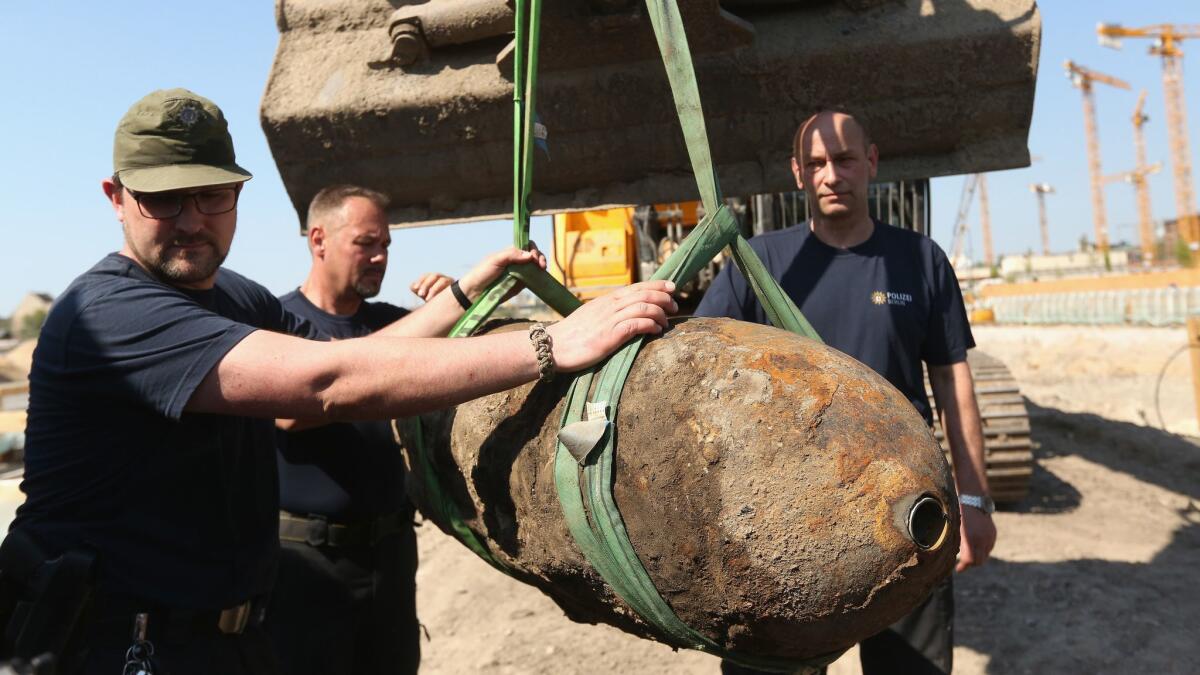Unexploded WWII bomb brings large-scale disruption to Berlin

Reporting from Berlin — Germany got a big, frightening reminder of World War II on Friday, after an unexploded 1,000-pound bomb was found buried just beneath the surface in the heart of Berlin and defused.
The operation forced more than 10,000 people to evacuate their apartments and offices and shut down the entire city center, including the country’s busiest central train station, which sees some 300,000 commuters daily. The area affected also included two government ministries, the country’s BND intelligence agency building, a hospital and a court building.
The bomb, dropped by the British Royal Air Force near the end of the war, stood dormant and rusting for more than 70 years. It had been unearthed at the bottom of a construction site and was defused Friday by police explosives experts, after a nerve-racking five-hour operation.
As Germans moved to defuse the bomb in Berlin, a similar operation was under way in Slovakia. The Associated Press reported that Slovak authorities conducted an evacuation in a town near the southern border with Hungary after four unexploded World War II bombs were found. People in the town of Sturovo were evacuated after the 220-pound Soviet bombs were found in a field.
It was not immediately clear how many people were being evacuated as experts removed the bombs and took them to a safe place, the AP said. The bombs were discovered by a man walking his dog.
The bomb in Berlin was one of an estimated 3,000 WWII duds still lurking under the city.
Police evacuated the area starting at 9 a.m., hours before the disposal operation began. There was concern that shrapnel from the bomb could cause injury or death and widespread destruction were it to detonate, as has happened on occasion in the past.
“It was a textbook operation,” Engin Lauber, the head of the police bomb disposal team, told reporters after the all-clear was sounded at 1:20 p.m. Lauber, aware of the dangers of his job, was philosophical. “We all know that it could have ended up differently. I do try to live every day like it could be my last.”
In 2010, three police officers were killed while preparing to defuse a 1,000-pound bomb found in the university town of Goettingen. Two others were killed in Hesse in 1990 while working to disable another unexploded bomb. In 2006, a highway construction worker was killed when his cutting machine detonated another bomb. In 1994, three construction workers in Berlin were killed in a similar accident.
Mostly stoic Germans accustomed to such disruptions took the shutdown of the city center in stride on a bright springtime morning — even though hundreds of trains were rerouted and tens of thousands of passengers stranded in the wrong stations. It was called the largest evacuation in central Berlin in memory, police said.
“We used a mechanical device to separate the detonator from the rest of the bomb, removed it and then destroyed it,” said Dietmar Puepke, one of the five police explosives experts who helped disable the bomb.
About 70,000 tons of bombs were dropped on Berlin by Allied forces during nearly 400 air raids during World War II, and experts believe that about 15% of those bombs failed to explode on impact, instead burying themselves up to 20 feet deep in the soil and rubble. About 2,000 tons of bombs and live munitions are found in the soil every year in Germany, a ghoulish reminder of the country’s 20th century past.
One of the biggest bombs ever found, a 4,000-pound “blockbuster” bomb dropped by Britain’s Royal Air Force, was defused in Frankfurt last year after 65,000 people had to be evacuated for most of the day.
In 2016, some 54,000 people had to be evacuated for another defusing operation on Christmas Eve in Augsburg, and 50,000 people had to leave their homes and offices in Hanover after another such discovery. Most of the bombs were in the 500 to 1,000-pound range.
In 2012, police were unable to defuse a 500-pound American bomb found in a construction site in Munich and their control detonation produced a fireball that lit up the nighttime sky, causing millions of dollars’ worth of damage to 17 buildings.
Kirschbaum is a special correspondent.
More to Read
Sign up for Essential California
The most important California stories and recommendations in your inbox every morning.
You may occasionally receive promotional content from the Los Angeles Times.










